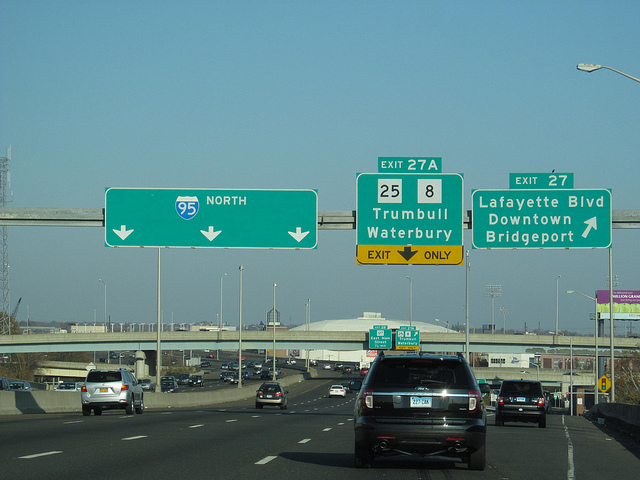It could take up to 30 years of tolling drivers to fund all the projects outlined in a tolling bill which passed out of the Transportation Committee on March 20, unless the state plans to increase bonding to pay for those projects.
Committee Bill 423 provided a list of 16 high-priority projects garnered from the Connecticut Department of Transportation’s five-year capital plan. Many of those projects were suspended when Gov. Dannel Malloy announced the Special Transportation Fund was out of balance in January of 2018.
The projects would be funded through a Transportation Priority Projects account – a new fund within the Special Transportation Fund.
According to numbers provided by the Connecticut Department of Transportation, those projects total $24.6 billion.
The project list contains $4.8 billion rail projects, including $809 million for repairs, stations and rail cars for the brand-new Hartford Line.
“Not all of these projects could be completed at the same time, but rather would be prioritized and sequenced in an orderly fashion,” said CT DOT spokesman Kevin Nursick. “Aside from these major projects, there are literally hundreds of projects that toll revenue would enable. Most importantly, additional revenue of $800 million would allow system-wide infrastructure improvements to achieve a state-of-good-repair.”
The project list contains $4.8 billion rail projects, including $809 million for repairs, stations and rail cars for the brand-new Hartford Line, which runs from New Haven to Springfield and was recently completed for nearly $800 million.
Gov. Ned Lamont’s budget estimates toll revenue to be $800 million per year, meaning it could take a long time before tolls could pay for the projects outlined in the bill, but the additional revenue from tolls could be used to leverage more transportation bonding.
In response to an inquiry regarding the projects listed in CB 423, CT DOT provided the following list of projects and estimated costs:
o Hartford I-84 Viaduct Project – $4.4 billion
o Heroes Tunnel in New Haven / Woodbridge – $200 million
o Gold Star Bridge in New London / Groton – $290.5 million
o I-84 Danbury Exits 3 – 8 Improvements – $1.5 billion
o I-84 Mixmaster Replacement in Waterbury – $7 billion
o I-95 West Congestion Mitigation – $1.2 billion
o Interchange of Routes 15 / 7 in Norwalk – $160 million
o I-91 / I-691 / Rte. 15 Interchange in Meriden – $180 million
o Remove Traffic Signals On Route 9 in Middletown – $75 million
o Hartford Line Stations – $340 million
o Hartford Line Rail Improvements – $164 million
o Rail Fleet Purchases – Remaining 61 cars out of 111 cars – $305 million
o New Haven Parking Garage – $80 million
o MetroNorth Moveable Bridges (Devon, Cos Cob, Sauga) -$4 billion
o Hartford I-84/I-91 Interchange – $4 billion
o I-95 East Congestion Mitigation – $750 million
There are some differences between what was listed in the tolling bill and what was provided by CT DOT. Notably, there is no plan to replace the Gold Star Bridge, but rather repair and make improvements to it. Secondly, the tolling bill lists repairs to the Mixmaster in Waterbury, whereas the CT DOT lists the cost of replacement.
However, some of the projects might not be allowable under the federal tolling guidelines referenced in the tolling bill.
However, some of the projects might not be allowable under the federal tolling guidelines referenced in the tolling bill.
The legislation says, “such expenditures shall be an eligible use of toll revenue pursuant to the provisions,” of the United States statutes.
However, those statutes say that toll revenue must be used for repair and maintenance of the road on which the revenue was collected until such time as a “public authority” deems the road to be in good repair.
The $4.8 billion in railroad projects may not be eligible for toll revenue until the work on highways has been completed.
Some of that highway work is fairly extensive, such as replacement of the Mixmaster in Waterbury, estimated to cost $7 billion, replacement of I-84 viaduct in Hartford for $4.4 billion, or work on the I-84/I-91 Interchange for another $4 billion.
Most of the projects listed in CB 423 were suspended in 2018 after a report by the CT DOT noted the Special Transportation Fund would fall into a $388 million deficit by 2022.
As part of the 2017 budget revision, lawmakers began to transfer vehicle sales tax revenue to the STF to balance the transportation fund’s budget and enable suspended projects to continue moving forward.
However, as part of his proposed budget, Gov. Ned Lamont wants to freeze that transfer, which would essentially leave the STF broke by 2021 and, instead, called for installing tolls on Connecticut’s highways.
Lamont has said toll revenue would reduce the state’s use of bonding for projects, which differs from the CT DOT’s plans, outlined in their annual report.
CT DOT was counting on an increase to state bonding to cover Gov. Dannel Malloy’s 30-year, $100 billion Let’s Go CT! infrastructure plan, which includes a number of the projects listed in the tolling bill passed out of the Transportation Committee.
Let’s Go CT!is still in it’s “ramp up” phase, according to DOT’s annual capital plan report. “The 5 year Ramp Up plan included $2.8 billion in additional bond authorizations, including an additional $520 million in FFY 2017 and $552 million in FFY 2018.”
The five-year ramp up ends in 2020, according to the report, but DOT assumes the state’s regular bond program “will increase by approximately $700 million” in FY 2021.
Debt service payments account for approximately 40 percent of STF spending. In his 2018 push for tolls, Malloy said the STF wasn’t taking in enough revenue to continue bonding for needed projects.
Republicans have pushed for their Prioritize Progress plan, which would prioritize state bonding for major projects without the need for tolls.


Frank DiGregorio
March 29, 2019 @ 8:05 am
Tolling is a tax increase that never goes away and will further push residents to flee the state.